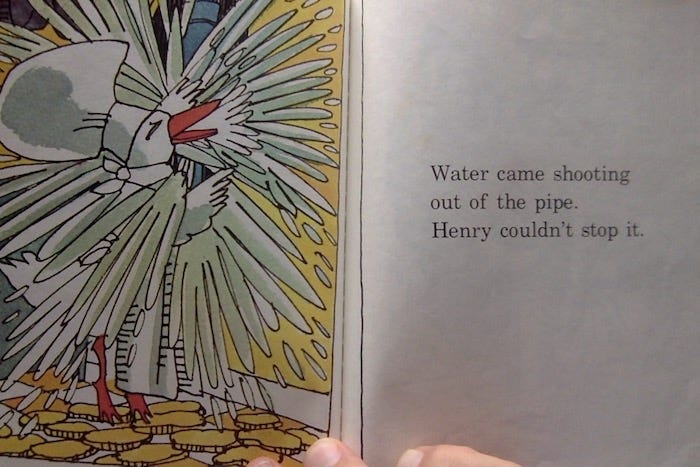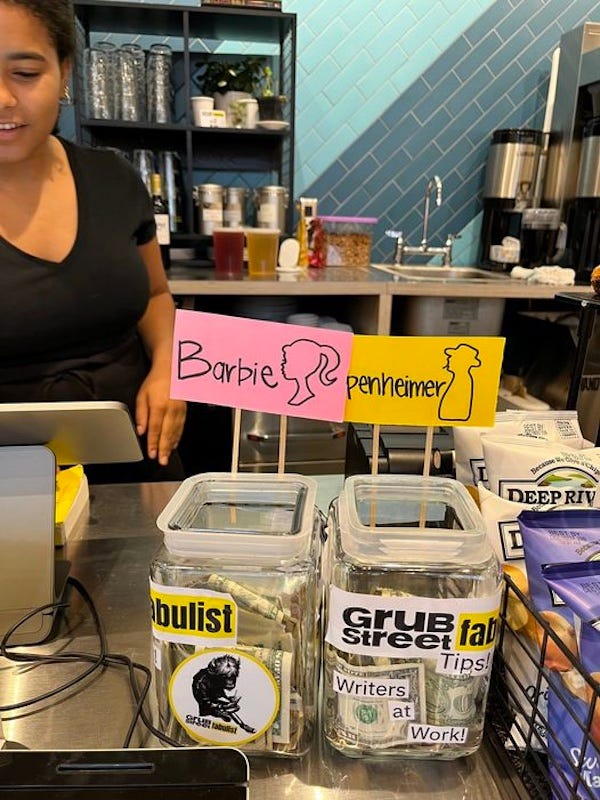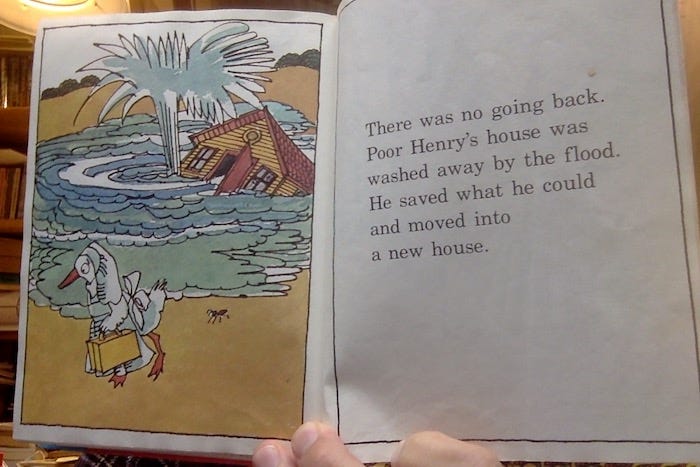Sundman's Awful Mistake, the stunning conclusion
Let me explain something to you, Walsh. In Sundman figures it out! there is no escape from narrative assessment
New here?
Welcome to Sundman figures it out! Here you will find that themes emerge, fade, reappear and interleave; incidents ramify and their import may change upon being revisited. Thus reading earlier posts may enhance your experience of reading this and subsequent essays. He said knowingly.
This here post
This here post is part three of a three-part series with seemingly disparate threads & topics skillfully woven to reveal an unexpected image — or maybe just thrown together, like unsorted flatware in a kitchen drawer1. In any event I’m not going to summarize the two earlier posts in this series because if I did we’d be here ‘til Sunday, and it’s only Monday, so where would that leave us? If you haven’t read (or don’t remember) those posts you’ll be under-awed by some of what I intend to drop here, but that’s your concern, it ain’t none of my nevermind. But should you be motivated, here’s a link to part one, and here’s one to part two.
We finally get to the story of my awful mistake with the water pipe in the substantial house in Gardner
This story goes back to around 1988.
As you recall, that “substantial” house in Gardner was a grand old manse, delightful in so many ways — but its plumbing not being one of them. You also recall that on the first floor of the house, at the back of the little yellow breakfast room, there was a broom closet with a narrow door. An in that closet were water pipes that supplied the second and third floors.
There was a problem with the shower control in the second-floor hallway bathroom, the bathroom with the clawfoot tub2 in which we gave our young children their baths. Unlike in the photo above, this shower control in this bathroom was built into a the wall. In order to repair or replace the malfunctioning control, I first had to find a way to turn off the water that fed it. My first thought was to see if there were shut-off valves in the little closet at the back of the breakfast room downstairs.
I don’t remember what happened in that closet. Somehow I must have caused a leak like the one that Henry Duck caused by smacking that water pipe with a hammer in his ill-considered attempt to smash an ant. Perhaps I forced a disused handle and something snapped? I don’t remember! It was so long ago! Our children were so young! All I recall is that somehow a leak sprang in that closet, and that I somehow fixed it.
I know this because after I took care of the leak I went upstairs to my four year old daughter’s room and got her copy of Henry’s Awful Mistake and brought it downstairs and left it on the kitchen table with a note for my wife to find when she arrived home with the children from wherever they had been. That book became special too me. That is why it still sits on the shelf in my office, among other masterpieces, such as Proust’s À la recherche du temps perdu and Crockford’s JavaScript: The Good Parts.
Hang on, we’ll get to the part about the easter egg soon.
We all have horizons of expectation
After reading Sundman’s Awful Mistake, part two, my friend Hamilton wrote me privately.
A few years ago I was getting a haircut in Rochester. I told the hairdresser I wanted to get it cut before leaving the country. She asked where I was going. I said - perhaps not very clearly - "Moscow." Which led her to ask, "Do you speak Spanish?"
When I tell this anecdote to German or Russian friends, they put it down to legendary American ignorance. That's also what I took it to be for a while. Somehow, though, that didn't feel like a sufficient explanation.
I thought back to the continuation of the conversation in the barber shop. It turned out that the hairdresser's boyfriend was from Mexico. In retrospect, I think that's a key fact.
It had likely never happened to her before that that a customer had said he was going to Moscow, but people she knew went to Mexico - as she was perhaps also thinking of doing.
We all have horizons of expectation – and if we experience something that does not fit into the horizon, we tend to interpret it so that it does fit. When I mumbled "Moscow," that was literally unbelievable to her ears, so she figured I must have said "Mexico." She took what was nonsense from her POV and turned it into sense.
Probably relatively few errors are caused by simple ignorance. More are caused by the incorrect interpretation of possible meanings.
This is exactly the kind of comment that I’m hoping for every time I click ‘publish’ on one of my finely wrought essays.
Although I do feel, like Lina Lamont, that if I have brought a little joy into your hum drum life then all my hard work ain’t been in vain for nuthin, still I hope, with each post I post, to rouse a few more of youze guyz to leave a thoughtful comment, to ‘share’ Sundman figures it out! with friend.
Yet you seldom do. Why is that? Perhaps my horizon of expectation for your response is not appropriate? Is that my awful mistake?
Barbenheimer
My friend the great novelist Nicole “Nicki” Galland recently posted this picture on Facebook with the caption “At Grub Street there is no escape from narrative assessment.”
Speaking of narrative assessment, here’s something Frank Kermode says on page 148 of The Sense of an Ending: Studies in the Theory of Fiction:
In a novel the beginning implies the end: if you seem to begin at the beginning, ‘It was a fine evening in 1922. I was at a notary’s clerk in Marommes,’ you are in fact beginning at the end; all that seems fortuitous and contingent in what follows is in fact reserved for a later benefaction of significance in some concordant structure.
You may wonder why I care about narrative assessment, why I keep bringing it up in one guise or another. Well, I will tell you: I am a storyteller; I am a novelist; I am a memoirist. I am one who thinks about narrative as a vocation and as an avocation. I am interested in both the art and the science of storytelling. That is why. If you’re interested in how we got off on the kermodian tangent, start here.
You may also wonder why it took Kermode until page 148 to establish one of the main theses of his book The Sense of an Ending — that the beginning of a novel implies its end — and my answer to that is, Who knows? Beats the shit out of me. I just wish he had set out his theses a little more clearly at the outset of his book. It would have saved me a lot of head-scratching.
Alas that’s all the narrative theory we have time for in today’s essay. But I promise ( I warn? I threaten?) you that we will have a lot more to say about literary theory in general and Kermode in particular in future episodes of Sundman figures it out!
By they way, the line “Let me explain something to you, Walsh. This business requires a certain amount of finesse,” hinted at in the subtitle for this post, is from the movie Chinatown. It’s said by Jake Gittes (Jack Nicholson). There’s no particular reason for me to allude to it in this essay. I just happen to like it.
An easter egg for the ages
The walls of that second floor bathroom of the house in Gardner were tiled with white tile from the floor to a height of about four feet; above that they were covered with bucolic-themed wallpaper.
The toilet was separated from the bathtub by a floor-to-ceiling partition. On the bathtub side that partition was completely tiled; that’s where the broken faucet-thingy was. To gain access to the fixture I would have to go in from the toilet side. Which would mean, you might think, that I would have to take a hammer, much as Henry Duck had done, and smash a hole in the toilet side of tiled wall. Smashing a hole in a wall of my nicely-tiled bathroom was not something I was looking forward to doing. So I was delighted to discover that no wall-smashing would be required.
Although we had lived in that house for at least three years by then, it wasn’t until I set about to replace the malfunctioning shower control that I noticed that the toilet-facing side of the partitioning wall wasn’t in fact tiled; rather, there was a large wallpapered panel there, neatly trimmed in a painted wood moulding affixed to the wall with four large screws. It was so skillfully done that I had never noticed that there was wallpaper at the level where tile should have been.
I got a screwdriver and removed the panel. Behind it I found a large ragged hole.

Clearly, somebody at some point in the past had had to take a hammer to the tiled wall and smash that hole in order to get access to the shower controls. Then, rather than rebuilding and retiling the wall after making their repair, they had come up with the ingenious solution of the removable wallpapered panel.
I set the panel aside, and I saw, hanging in that recess from a string affixed to the a lath on the shower-side of the cavity, a cartoon, clipped from a magazine or newspaper, that looked like this3:

After I had replaced the shower valve I carefully replaced the covering panel, leaving the cartoon as I had found it. That was nearly forty years ago. The house has had at least three different owners since then. I wonder if any of them have seen that cartoon?
Nicole Galland assesses narrative
Among her many claims to fame, Nicki Galland is co-author, with Neal Stephenson, of the international bestseller The Rise and Fall of D.O.D.O.
Here’s what Nicki has to say about my little novella Cheap Complex Devices. It’s only 44 seconds long. Won’t you take a look?
You can see the rest of my conversation with Nicole Galland here. She’s a great novelist with a lot of interesting things to say about the craft of writing. If you care about that kind of thing you should check it out.
Promo
Sign up for an author’s newsletter, get a free book. If you’re already subscribed to Sundman figures it out!, use that address.
This promo includes my hackertastic thriller Biodigital: A novel of technopotheosis.
Epilogues
Because Henry’s Awful Mistake is, inter alia, a children’s book, it has a bit of a happy ending. Henry builds a new home and again invites Clara for supper. Just as she arrives, Henry notices an ant. “He look[s] the other way.”
That’s nice for kids, but we’re adults here; we have to deal with reality, with whatever wreckage our awful mistakes may have left for us to clean up. So I just leave you with this illustration. I hope that you will find in it a concordant structure of sufficient benefaction.
I have a story about that. It takes place in Ashburnham, MA. Remind me to tell it to you sometime.
Actually I don’t remember if the second-floor bathtub was a clawfoot, but the one on the third floor was. In any event the house was essentially Victorian, inside and out, even if it had been updated here and there. I really am going to have to find some photos for you.
Unable to locate the original artwork, I described it from memory to my friend & amateur cartoonist Mateo, who recreated it for you to enjoy.










Regarding the entombed cartoon; My friend, Bloxberg, just sold his house and behind the built-in microwave there is a note that says "Look behind the water softener." Should the new owners find the note and do as instructed they will find another note, and so on ... I don't know how long the chain of notes is or what he's left at the final destination but while there is a sense of an ending revealed by the first note, the terminus is somewhat irrelevant (it could well be "look behind the microwave") so in this case, it's the journey that matters.
Plumbing is not amateurs. I scored a rare victory over a "touch" faucet that had taken on a life of its own. A short (26 second) youtube video provided the game plan. There was some minor flooding but at the end of the day the faucet worked.
I won't be leaving any notes for the next homeowner but will leave a list with the phone numbers of all the professionals who tend to the pellet stove, the boiler and the pool. Both the least and the best I can do.